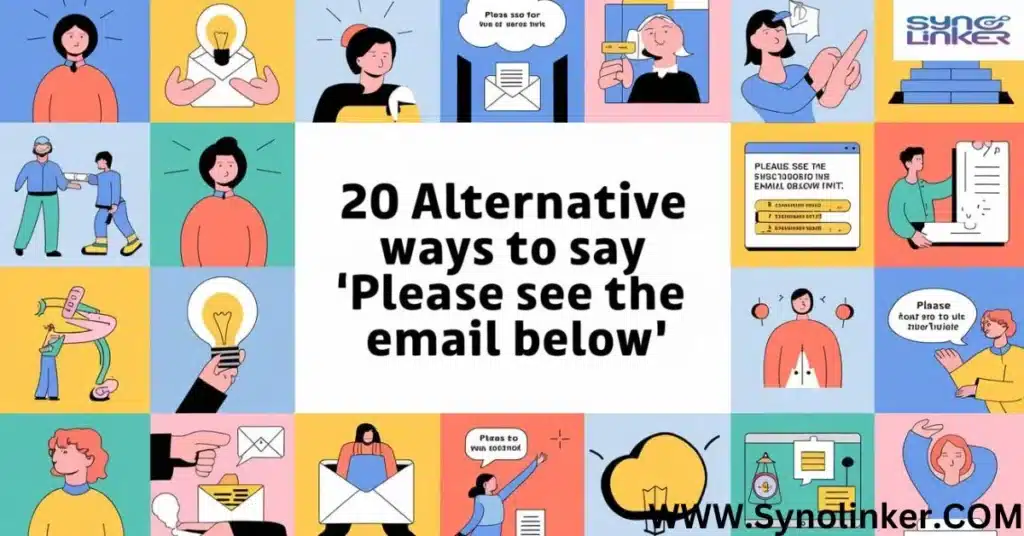In today’s fast-paced digital world, email communication reigns supreme. We’ve all been there, forwarding crucial information or referencing previous conversations. But let’s face it, constantly saying “please see the email below” can get repetitive and dull.
Fear not! I’ve got your back with 20 alternative ways to freshen up your email language and keep your colleagues engaged. These professional ways will help you maintain a polite yet interesting tone in your correspondence.
Is It Professional To Say “Please See the Email Below”?
While “Please see the email below” is a common phrase in professional communication, it can sometimes come across as abrupt or overused. Professional ways to reference previous emails often involve more context or specificity. However, in situations where brevity is key, this phrase can be acceptable. The key is to consider information like your relationship with the recipient and the email’s context when choosing your wording.
Here Are 20 Alternative Ways To Say “Please see the email below”
- I’ve attached the previous correspondence for your reference.
- Kindly review the email thread below.
- For context, check information in the forwarded message.
- I’ve included the original email for your perusal.
- Please see the details in the email chain below.
- For your convenience, I’ve forwarded the relevant email.
- Consider information shared in the previous message.
- Take a moment to review email content below.
- I’ve appended the original message for clarity.
- Refer email below for the full picture.
- The following email provides essential background.
- I’ve included the subsequent email for your records.
- Peruse email content below at your earliest convenience.
- The attached email contains relevant information.
- For reference, I’ve copied the original message below.
- Check information in the previous email for context.
- I’ve included the full email chain for your review.
- See details shared earlier in this thread.
- I’ve forwarded the subsequent email for your attention.
- The email trail below offers valuable insights.
1. “I’ve attached the previous correspondence for your reference.”
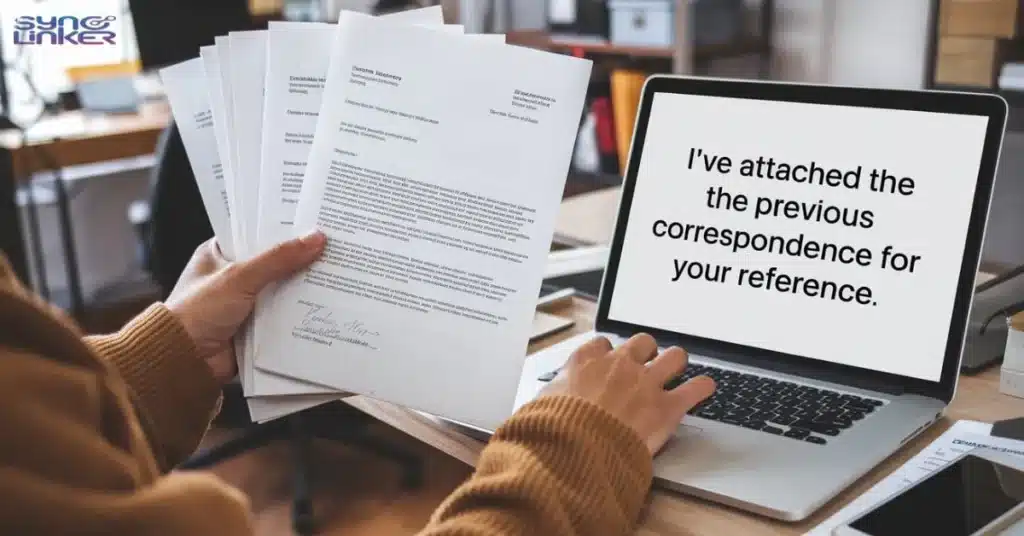
This polite phrase works wonders when you’re looping someone new into an ongoing discussion. It’s one of the most polite ways to direct attention to important information without sounding bossy.
Example:
Hi Sarah, I hope this email finds you well. I’ve attached the previous correspondence for your reference regarding the Anderson project. Could you weigh in on the proposed timeline adjustments? Your expertise would be invaluable here. Best regards, Alex
You might be interested 20 Other Ways to Say “Happy Birthday”
2. “Kindly review the email thread below.”
Perfect for situations where you need someone to catch up on a series of exchanges. This phrase politely asks the recipient to review email content without sounding demanding.
Example:
Hey Tom, I trust you’re having a great week. Kindly review the email thread below when you get a chance. It’ll bring you up to speed on our project timeline changes. I’d love to get your thoughts on the new deadlines proposed by the client. Cheers, Emma
3. “For context, check information in the forwarded message.”
This is a great way to provide background without sounding too formal. It’s one of those other ways to say “please see the email below” that feels more conversational and helpful.
Example:
Clara, Hope your day’s going well! We need to adjust our marketing strategy for Q4. For context, check information in the forwarded message from our analytics team. Their insights on consumer behavior trends are eye-opening. Let’s chat about this tomorrow? Best, Mark
4. “I’ve included the original email for your perusal.”
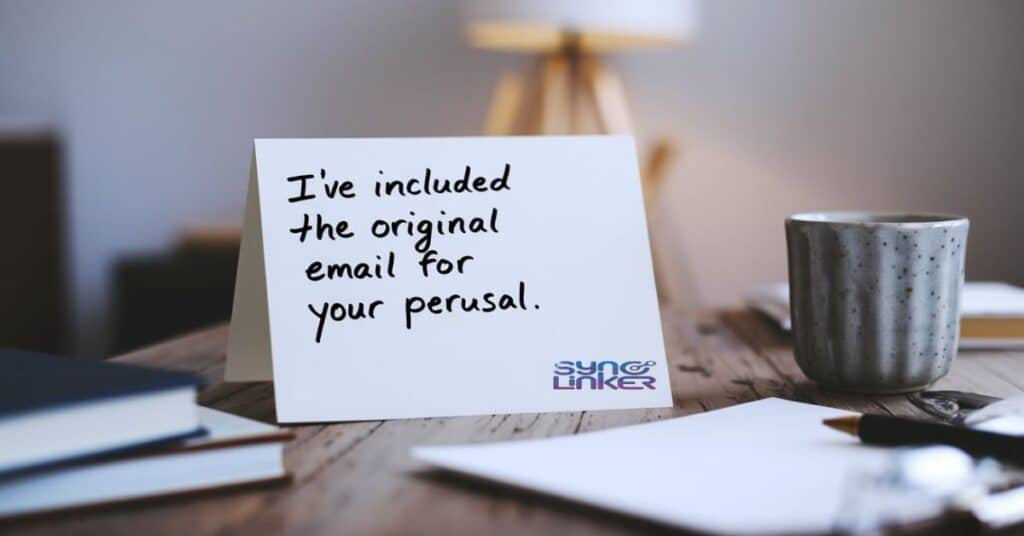
When you want to sound professional but not stuffy, this phrase hits the spot. It’s a subtle way to ask someone to peruse email content without being overbearing.
Example:
Dear Mr. Johnson, I trust this message finds you well. I’ve included the original email for your perusal. It outlines the terms we discussed in our meeting last week regarding the merger. Please let me know if you need any clarification on the points mentioned. Kind regards, Samantha Lee SVP, Corporate Strategy
5. “Please see the details in the email chain below.”
This classic with a twist works well when there’s a lot of back-and-forth to catch up on. It’s a straightforward way to direct attention to an email chain without sounding repetitive.
Example:
Hi Team, I hope everyone’s having a productive week. Please see the details in the email chain below regarding our upcoming client presentation. There are some key points about their expectations that we should discuss in our next huddle. Looking forward to your input! Best, David
Read more grammar lessons on Synolinker
6. “For your convenience, I’ve forwarded the relevant email.”
This phrase shows you’re being thoughtful about the recipient’s time. It’s one of those professional ways to reference previous communications that demonstrates consideration.
Example:
Hello Lisa, I hope this message finds you well. For your convenience, I’ve forwarded the relevant email containing the conference schedule and speaker lineup. Looking forward to seeing you at the event next month! Warm regards, Michael
7. “Consider information shared in the previous message.”
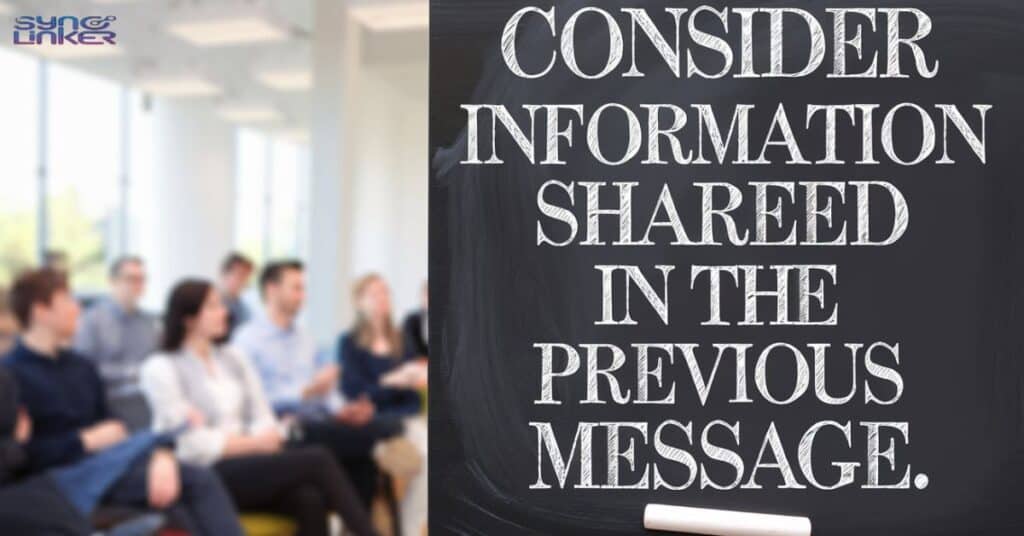
When you need someone to really think about the content, this phrase does the trick. It’s a subtle way to emphasize the importance of the information without being pushy.
Example:
Hey Alex, Hope you’re having a great day! Before our strategy meeting this afternoon, consider information shared in the previous message. It contains some intriguing data about market trends that might change our approach to the Thompson account. See you at 3! Cheers, Rachel
8. “Take a moment to review email content below.”
This gentle prompt encourages the recipient to pause and absorb the information. It’s one of the more polite ways to ask someone to pay attention to important details.
Example:
Dear Marketing Team, I hope this email finds you all in good spirits. When you have a moment, take a moment to review email content below. It contains crucial data from our recent customer survey that will inform our upcoming campaign launch. Let’s discuss these insights in our team meeting tomorrow. Best regards, Jason Head of Marketing
9. “I’ve appended the original message for clarity.”
When you want to sound precise and helpful, try this phrase. It’s a formal yet friendly way to refer email content without sounding repetitive.
Example:
Hi Dr. Patel, I trust you’re doing well. I’ve appended the original message for clarity regarding the research grant application. It includes some specific requirements that weren’t initially clear. Let me know if you need any additional information or assistance with the application process. Best wishes, Emily Johnson Research Coordinator
Read more about 20 Fresh Ways to Say “Have a Great Rest of Your Week”
10. “Refer email below for the full picture.”
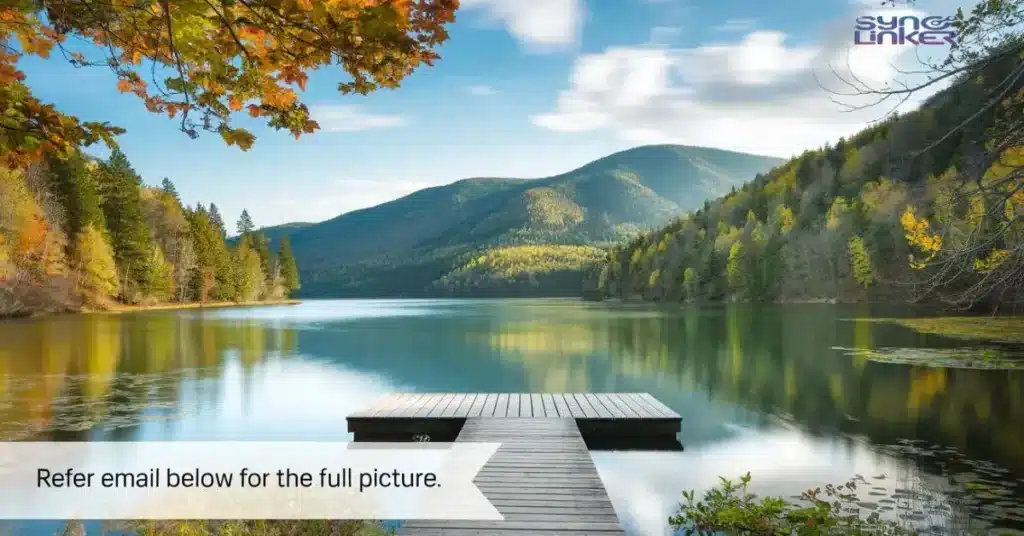
This casual yet clear phrase works well with colleagues you know well. It’s a friendly way to ask someone to check information without sounding too formal.
Example:
Hey Jamie, How’s it going? Refer email below for the full picture on why we’re changing suppliers. It’s got some interesting cost comparisons and quality assessments. Thoughts? I’d love to hear your take on this before our meeting with procurement. Catch you later, Chris
11. “The following email provides essential background.”
Use this when the information you’re forwarding is crucial for understanding the current situation. It’s a professional way to emphasize the importance of the content.
Example:
Dear Board Members, I hope this message finds you all well. The following email provides essential background on the merger discussions with XYZ Corp. Please review this information before our emergency meeting this afternoon. It contains key financial projections and potential synergies that will guide our decision-making process. Looking forward to our discussion. Regards, Amelia Santos CEO
12. “I’ve included the subsequent email for your records.”
This formal-sounding phrase is perfect for situations requiring documentation. It’s one of those professional ways to reference important communications that might be needed later.
Example:
Hello HR Team, I hope you’re all having a productive week. I’ve included the subsequent email for your records regarding the resolution of the workplace incident last week. It outlines the steps taken and the agreement reached with all parties involved. Please file this appropriately for future reference. Best regards, Thomas Chen Legal Department
13. “Peruse email content below at your earliest convenience.”
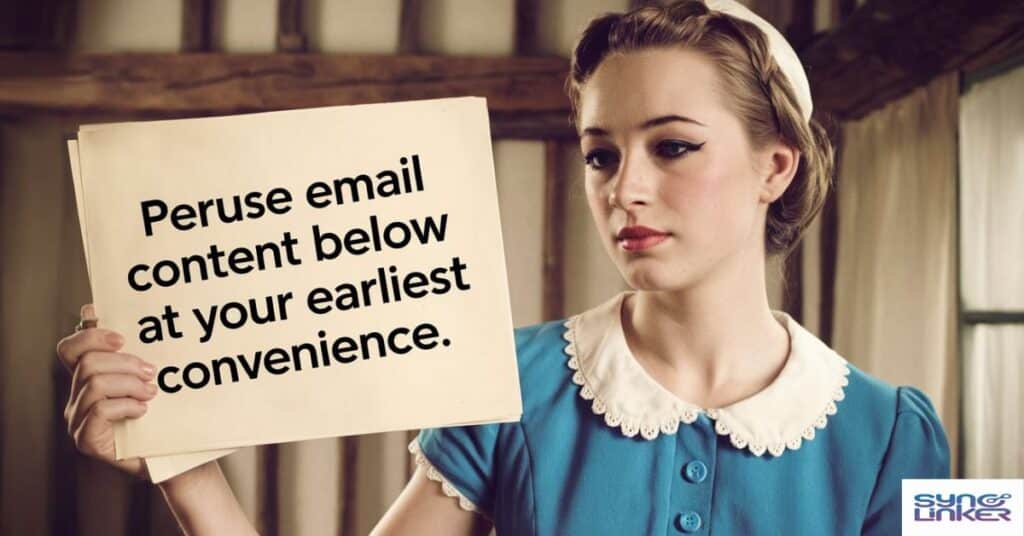
When you need someone to look at the information but it’s not urgent, this phrase strikes the right tone. It’s a polite way to ask someone to review email content without pressuring them.
Example:
Hi Raj, I hope this email finds you well. When you have a moment, peruse email content below at your earliest convenience. It’s about the new project management software we’re considering. I’d love to get your thoughts on its features and how it might streamline our workflow. No rush, but it would be great to discuss this before our team meeting next week. Cheers, Sophia
14. “The attached email contains relevant information.”
This straightforward phrase works well in most professional contexts. It’s a clear and concise way to direct attention to important details.
Example:
Dear Ms. Thompson, I hope this message finds you well. The attached email contains relevant information about our company’s sustainability initiatives. We believe these align well with your organization’s environmental goals. We’d love to discuss potential partnerships and how we can work together towards a greener future. Looking forward to your thoughts. Best regards, Daniel Green Sustainability Director
15. “For reference, I’ve copied the original message below.”
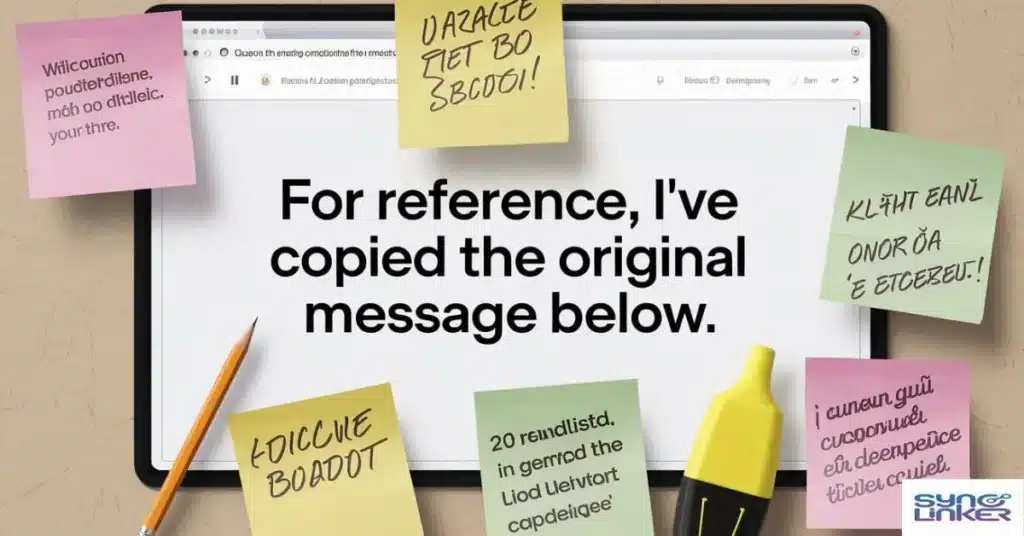
When you want to be helpful without being pushy, this phrase does the job. It’s one of those polite ways to provide context without overwhelming the recipient.
Example:
Hello Accounting Department, I hope you’re all doing well. For reference, I’ve copied the original message below regarding the new expense report system. It outlines the key features and implementation timeline. Feel free to reach out if you have any questions or concerns about the transition. Best, Laura IT Support
16. “Check information in the previous email for context.”
This casual yet clear phrase works well for internal communications. It’s a friendly way to ask colleagues to refer email content without sounding too formal.
Example:
Hey Design Team, Hope you’re all having a creative day! Check information in the previous email for context on the client’s feedback for the website redesign. They had some interesting points about color scheme and user experience. Let’s brainstorm solutions in our next meeting. I’m excited to see what we come up with! Cheers, Olivia
17. “I’ve included the full email chain for your review.”
When there’s a long history of communication to catch up on, this phrase is your friend. It’s a professional way to ask someone to review email exchanges without overwhelming them.
Example:
Dear Legal Team, I trust this email finds you well. I’ve included the full email chain for your review regarding the ongoing patent dispute with InnoTech. The correspondence includes their initial claims, our responses, and the most recent settlement offer. Your insights on our next steps would be greatly appreciated. Should we consider their offer or prepare for litigation? Thank you for your expertise in this matter. Best regards, Robert Cheng IP Manager
18. “See details shared earlier in this thread.”
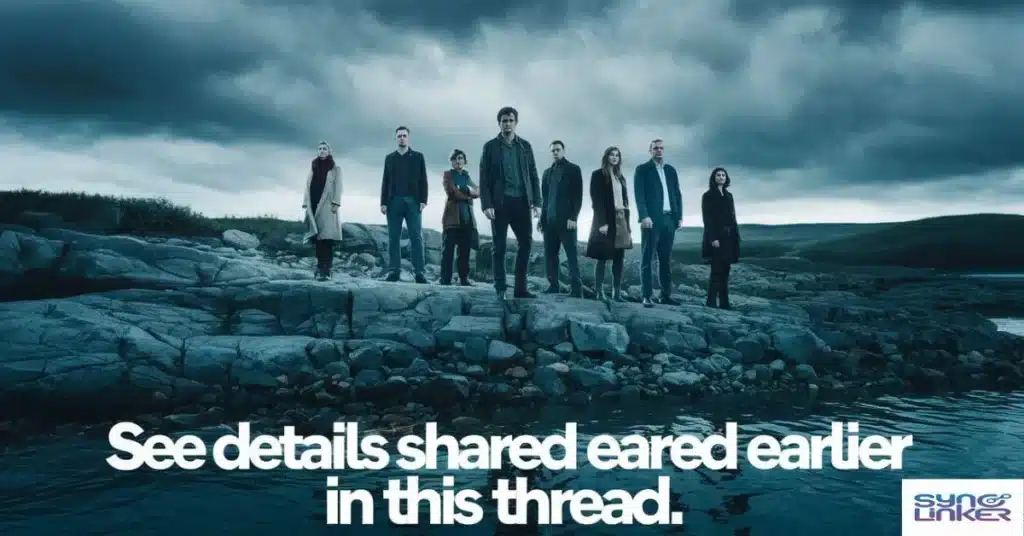
This concise phrase is perfect for quick follow-ups. It’s one of those other ways to reference previous information without repeating yourself.
Example:
Hi Sam, Hope your week is off to a great start! See details shared earlier in this thread about the product launch timeline. Can you confirm we’re still on track for the milestones outlined? If there are any potential delays or issues, let’s discuss ASAP so we can adjust accordingly. Thanks! Zoe
19. “I’ve forwarded the subsequent email for your attention.”
When you need to draw focus to a specific piece of information, try this phrase. It’s a professional way to highlight important updates or changes.
Example:
Hello Quality Control Team, I hope this message finds you all well. I’ve forwarded the subsequent email for your attention. It contains updated safety protocols from the regulatory board that we need to implement immediately. Please review these changes carefully and update our procedures accordingly. We’ll need to train all staff on these new protocols by the end of the week. Let me know if you have any questions or concerns. Best regards, Nathan Operations Manager
20. “The email trail below offers valuable insights.”
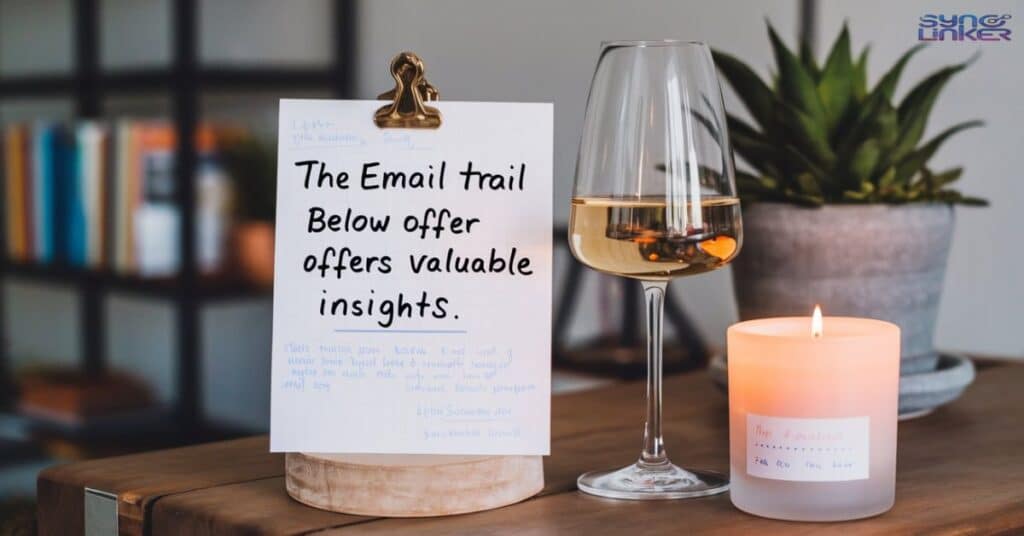
This phrase adds a touch of intrigue, encouraging the recipient to dig into the information. It’s a subtle way to emphasize the importance of the content without being too pushy.
Example:
Dear Investors, I hope this email finds you in good spirits. The email trail below offers valuable insights into our startup’s growth trajectory over the past quarter. You’ll find detailed analytics on user acquisition, retention rates, and revenue growth. We’re excited to discuss these trends and our future projections in our upcoming meeting. Your input will be crucial as we plan our next phase of expansion. Looking forward to our discussion. Best regards, Aisha Patel Founder & CEO
Wrapping Up: Mastering the Art of Email Communication
As we’ve explored these 20 alternative ways to say “please see the email below,” it’s clear that effective email communication is an art form. By employing these synonyms and other ways to reference previous correspondence, you can maintain a professional, engaging, and varied tone in your emails.
Remember, the key to successful email communication isn’t just about finding different ways to say the same thing. It’s about clarity, context, and consideration for your reader. Whether you’re asking someone to review email content, check information, or simply consider information shared, your goal is to make it easy and appealing for them to do so.
Tips to keep in mind
Here are some final tips to keep in mind:
- Context is key: Always provide enough background information to make your request clear and actionable.
- Know your audience: Tailor your language to your relationship with the recipient. More formal phrases work well for upper management or clients, while a casual tone might be better for close colleagues.
- Be concise: While it’s important to be polite, don’t bury your main point in unnecessary words. Get to the heart of your message quickly.
- Highlight importance: If you’re referencing a particularly crucial piece of information, don’t be afraid to emphasize its significance.
- Follow up: If you haven’t received a response and the matter is urgent, don’t hesitate to send a polite follow-up email.
- Use formatting wisely: Bold or italicize key points to make them stand out, especially in longer email chains.
- Proofread: Always double-check your email for typos or unclear phrasing before hitting send.
By mastering these techniques and incorporating the alternative ways we’ve discussed to reference previous emails, you’ll elevate your professional communication skills. Your emails will be clearer, more engaging, and more likely to elicit the response you’re looking for.
Remember, effective communication is at the heart of successful business relationships. By taking the time to craft thoughtful, well-structured emails, you’re not just sharing information – you’re building stronger professional connections.
So, the next time you’re about to type “please see the email below,” pause for a moment. Consider reaching for one of these alternatives instead. Your colleagues (and your writing skills) will thank you!

Emily Hanis is an experienced writer with a passion for all things grammar. With years of expertise in the field, she brings clarity and creativity to her content, making complex language rules easy to understand. On her blog, Emily shares practical tips, grammar insights, and a rich collection of synonyms to help readers enhance their writing skills. Her engaging style makes learning grammar both informative and fun.

